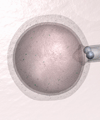September
Parliament debates Newcastle University technique

A pioneering fertility technique developed at Newcastle University, which allows the successful transfer of DNA between two human eggs, was debated in Parliament.
The House of Commons discussed the technique, which is hoped would prevent a host of inherited disorders known as mitochondrial diseases. It is the first time such a technique has been used and the landmark project has the potential to help hundreds of people the UK.
It is expected that a full debate in both houses of Parliament will be held later this year, with a vote o whether to allow the technique.
Mitochondrial diseases are passed on by the mother and the new technique would reduce the risk of transmission of these life-limiting disorders. This would allow a mother to give birth to a healthy child and eliminate mitochondrial diseases from the family line.
Mitochondrial diseases include muscular weakness, blindness, fatal heart failure, liver failure, learning disability and diabetes and can lead to death in early infancy.
The fertility treatment involves taking the nucleus of an embryo from a mother with defective DNA and putting it into the egg of a woman with healthy DNA. This healthy egg is then implanted back into the first woman, allowing them to create a baby free of genetic disease.
A child produced this way would have DNA from two women and a man. The nuclear DNA, which influences characteristics such as sex, height and eye colour, would come from the mother and father. Only 0.05% of DNA is from the female donor.
Professor Doug Turnbull, director of the Wellcome Trust Centre for Mitochondrial Research at Newcastle University is leading the groundbreaking treatment.
He said: “Mitochondrial DNA disease runs in families and there is no cure. The techniques we are working on could help hundreds of women have healthy children.”
published on: 2 September 2014
